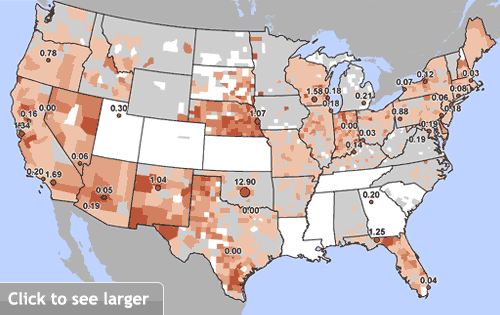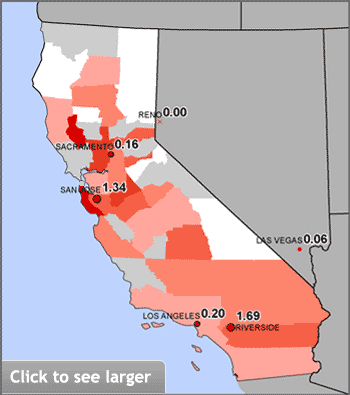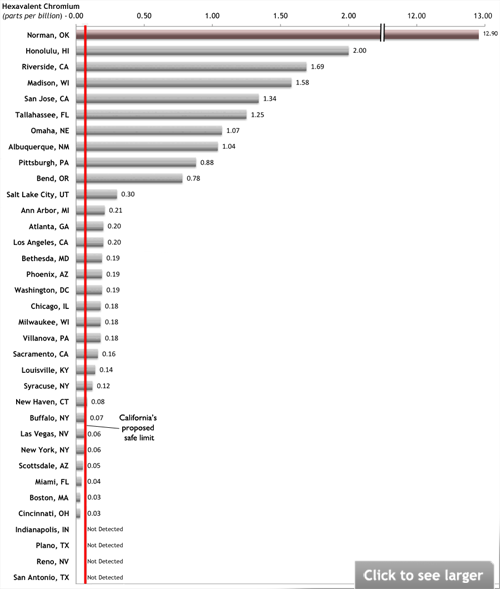by Andrew Walden
According to news released today from Erin Brockovich’s Environmental Working Group, Honolulu is on the chemophobia hit list--but it would take action by the State legislature or the US EPA for her to make her any money out of it.
The EWG tested municipal water from 35 US cities and Honolulu’s two parts per billion (2ppb) concentration of hexavalent chromium came up second only to Norman, OK. The four California cities which are Brockovich’s primary litigation targets all scored lower than Honolulu but higher than EWG’s proposed California state concentration limit.
Hexavalent chromium has long been identified as a carcinogen when inhaled by stainless steel smelters or welders—but never when imbibed. The US EPA sets a limit of 100ppb hexavalent chromium in water—50 times higher than Honolulu’s current level—not for cancer but rather to prevent skin irritation. But since it is a carcinogen when inhaled, chemophobia profiteers deified by Hollywood call it a “deadly cancer-causing chemical” in their efforts to stampede Legislators to establish grounds for litigation.
Hexavalent chromium, and its more common relative trivalent chromium, occur naturally in ground water as a result of contact with subsurface mineral formations. Trivalent chromium is a mineral without which the human body would be unable to metabolize glucose. Chromium of both types is so widely available as a natural component of various foodstuffs that the only known cases of chromium deficiency come from hospital patients fed on an intravenous drip for extended periods of time. Humans constantly ingest both hexavalent chromium and trivalent chromium as a normal part of their diet.
In 1996 Brockovich scored $333M from California’s PG&E after tying elevated hexavalent chromium levels in groundwater at Hinkley, CA to the use of the chemical in a PG&E facility. In 2006 Brockovich scored another $336M from PG&E for a similar groundwater “contamination” case from a similar PG&E facility in the Kettleman Hills area of King Co, CA.
California is the only state requiring water systems to prepare fodder for lawyers by testing specifically for hexavalent chromium. All other states recognize that since it is not dangerous in water, there is no need to test. The Washington Post December 13, 2010 points out Hinkley actually has lower-than-average cancer rates:
A California state study has not revealed elevated cancer levels in the town of Hinkley, a small desert community that inspired the award-winning Hollywood movie "Erin Brockovich" through its struggles with contaminated groundwater.
The California Cancer Registry has completed three studies on Hinkley, where a toxic (sic) plume of cancer-causing (sic) chromium 6 is once again growing. The studies found that cancer rates remained unremarkable from 1988 to 2008….
Epidemiologist John W. Morgan says the 196 cases of cancer reported during the most recent survey of 1996 through 2008 were less than what he would expect based on demographics and the regional rate of cancer.
Having had a movie made about her groundbreaking redistribution of wealth, Brockovich need not worry about the lack of actual cancers. Her “Environmental Working Group” is now pushing to reduce California’s hexavalent chromium limit to 0.06 ppb. If she is successful Los Angeles, San Jose, Sacramento, and Riverside would become very juicy targets for her litigation team.
In comparison, a study often cited by chemophobe activists is described by the Wall Street Journal:
During China's Cultural Revolution 40 years ago, a city doctor named Zhang JianDong was banished to the countryside of northeastern China. He arrived to a public-health emergency.
A giant smelter was spilling large amounts of chromium waste into the groundwater. Well water was turning yellow. People were developing mouth sores, nausea and diarrhea. Dr. Zhang spent the next two decades treating and studying the residents of five villages with chromium- polluted water.
In 1987, he published a study saying they were dying of cancer at higher rates than people nearby. He earned a national award in China for his research. In America, federal scientists translated it into English, and regulatory agencies began citing it as evidence that a form of the metal called chromium-6 might cause cancer if ingested.
Conveniently they ignore the possibility that the villagers were being affected by some other chemical or the very real possibility that they were affected by inhaled hexavalent chromium from the smelter—which is the one well-known source of identified carcinogenic reactions. A typical Maoist environmental monstrosity is being translated into ecobucks in pristine American courtrooms. Poisonous yellow well water is being translated into evidence against concentrations so small that they are almost impossible to detect under the most advanced laboratory conditions.
At 2ppb, Honolulu is 1/50th of the current US EPA legal limit. Unless the Obama EPA acts on behalf of trial lawyers, the Hawaii Legislature will have to establish a limit lower than 2ppb for Brockovich to have an opportunity to extract millions from the City, but that would be very unprofitable for the corporatist State since much of the money would be exported to California. To make money from this, Legislators and lawyers could decide to blame any Hawaii business which has ever touched stainless steel and extract the money from them, but that would mostly redistribute local money unless insurers could be forced to bear the burden. Another avenue for profit would be to blame the military and use this as a basis to prepare to scam a billion or two from Congress the next time Democrats take over.
It is critical not to acknowledge that Honolulu’s chromium comes from natural mineral content of groundwater. If anyone admits this truth, the basis for multi-million dollar litigation disappears. Remember: Loose lips sink suits.
---30---
News Release: Carcinogenic Erin Brockovich Chemical Found in Tap Water Across the U.S.
From Environmental Working Group December 20, 2010 (Excerpts)
Top five chromium-contaminated cities tested by EWG
| City |
City Population |
Hexavalent Chromium Contamination Level in Tap Water |
| Norman, Oklahoma |
89,952 |
12.9 ppb |
| Honolulu, Hawaii |
661,004 |
2.00 ppb |
| Riverside, California |
280,832 |
1.69 ppb |
| Madison, Wisconsin |
200,814 |
1.58 ppb |
| San Jose, California |
979,000 |
1.34 ppb |
Tests commissioned by the Environmental Working Group (EWG) detected carcinogenic hexavalent chromium in 31 of 35 tap water samples — 89 percent — collected in cities across the country. EWG targeted a mix of large cities and some smaller ones where testing by local water utilities had previously detected potentially significant amounts of “total chromium.” This less specific measurement includes trivalent chromium, an essential mineral that regulates glucose metabolism, as well the cancer-causing hexavalent form, also called chromium-6.
Chromium widely contaminates U.S. tap water

Red dots indicate EWG’s test sites and measured hexavalent chromium concentrations in parts per billion (ppb). Size of dot reflects the level found. Brown-shaded areas represent population-adjusted average concentrations of total chromium by county, calculated from EWG’s national tap water database (see Study Methodology).
Sources: EWG-commissioned testing for hexavalent chromium in tap water from 35 cities; EWG analysis of water utility testing data obtained from state water agencies (EWG 2009).
Hexavalent chromium (or chromium-6) gets into water supplies after being discharged from steel and pulp mills as well as metal-plating and leather-tanning facilities. It can also pollute water through erosion of soil and rock.
In California, the only state that requires water utilities to test for hexavalent chromium, the state’s Environmental Protection Agency (California EPA) has proposed a “public health goal,” or maximum safe concentration, of 0.06 parts per billion (ppb) in tap water to protect against excess cancer risk. However, the state’s current testing protocols are significantly less sensitive than those of the independent laboratory hired by EWG and may identify only the most extreme cases of contamination. Chromium-6 levels in tap water in all four California cities tested by EWG exceeded the proposed public health goal. (Once the goal is established, state regulators plan to embark on a rule-making process to set a legally enforceable upper limit.)
Chromium-6 is a common pollutant in California tap water

EWG measured concentrations of hexavalent chromium in four California cities — Los Angeles, Riverside, Sacramento and San Jose. Size of red dots reflects the level found. Colored areas reflect population-adjusted average concentrations of hexavalent chromium by county, as calculated from EWG’s tap water database (see Study Methodology). The state’s current testing protocols cannot detect chromium-6 in amounts lower than 1 ppb, more than 16 times higher than the proposed safe level.
Sources: EWG-commissioned testing for hexavalent chromium in tap water from four California cities; EWG analysis of water utility testing data obtained from state water agencies (EWG 2009).
Nationally, samples from 25 cities tested by EWG had levels of hexavalent chromium higher than the safe limit proposed in California.
Chromium-6 levels in 25 cities’ tap water exceed safe limit proposed by California officials*

Source: EWG-commissioned testing for hexavalent chromium in tap water from 35 cities.
For total chromium, the US Environmental Protection Agency has set a legal limit of 100 ppb in tap water to protect against “allergic dermatitis” (skin irritation or reactions). California’s legal limit for total chromium is half that — 50 ppb.
EWG’s analysis of California’s tap water testing data indicates that chromium-6 constitutes more than half of the total chromium found in most water supplies, a finding further supported by initial data from EWG’s nationwide survey. A proprietary 2004 study by the Water Research Foundation for its paying members, including water utilities, found that hexavalent chromium contamination of tap water was more common for systems using groundwater wells than for those drawing surface water (AWWARF 2004). The EPA’s 100 ppb legal limit for total chromium is more than 1,600 times higher than the California’s proposed public health goal for hexavalent chromium. This could mean that communities with higher concentrations of total chromium face a cancer risk well above the levels typically considered safe.
---30---
REALITY: Reflections on Hexavalent Chromium: Health Hazards of an Industrial Heavyweight
Here’s the kind of ignorance which is coming:
SLATE: "Erin Brockovich Chemical" Found in 31 Cities' Tap Water (notes added)
A new study reveals that tap water in as many as 31 U.S. cities contains hexavalent chromium, the "Erin Brockovich chemical" and "probable carcinogen" that's been linked to cancer.(1) According to the study by the Environmental Working Group, up to 74 million people "regularly drink chromium-tainted water," (2) with Norman, Okla.; Honolulu, Hawaii; Riverside, Calif.; and Madison, Wisc. reporting the highest levels of the chemical in drinking water. This is the first national analysis of hexavalent chromium's presence in tap water that's been released to the public, and researchers were caught off guard (3) by the findings. "I was expecting to find hexavalent chromium in some of the cities we checked but I didn't expect it to be so widespread," said lead author Rebecca Sutton. Last year, California paved the way for regulating the chemical by proposing a "public health goal" to reduce the levels of hexavalent chromium in drinking water, and the Environmental Protection Agency is also debating whether to set limits. At the moment, scientists say that there is little oversight—either in tap water, or elsewhere. "Bottled water is not necessarily any safer than tap water," Sutton said. "We just don't have any guarantee that hexavalent chromium isn't in that water." (4)
1) No it is not a carcinogen in solution.
2) All water and food is “chromium tainted.” So, counting food, it is not 74M who “regularly drink chromium tainted water” it is 6 billion. Without chromium we would all die.
3) No, the researchers were not “caught off guard.” Where there is chromium, there is hexavalent chromium. They knew exactly what to expect and focused on water systems with the highest chromium levels in order to find the highest hexavalent chromium levels.
4) Hexavalent chromium is everywhere. It has been for 4 billion years.






*Proposed safe limit is California EPA's proposed public health goal (OEHHA 2009).